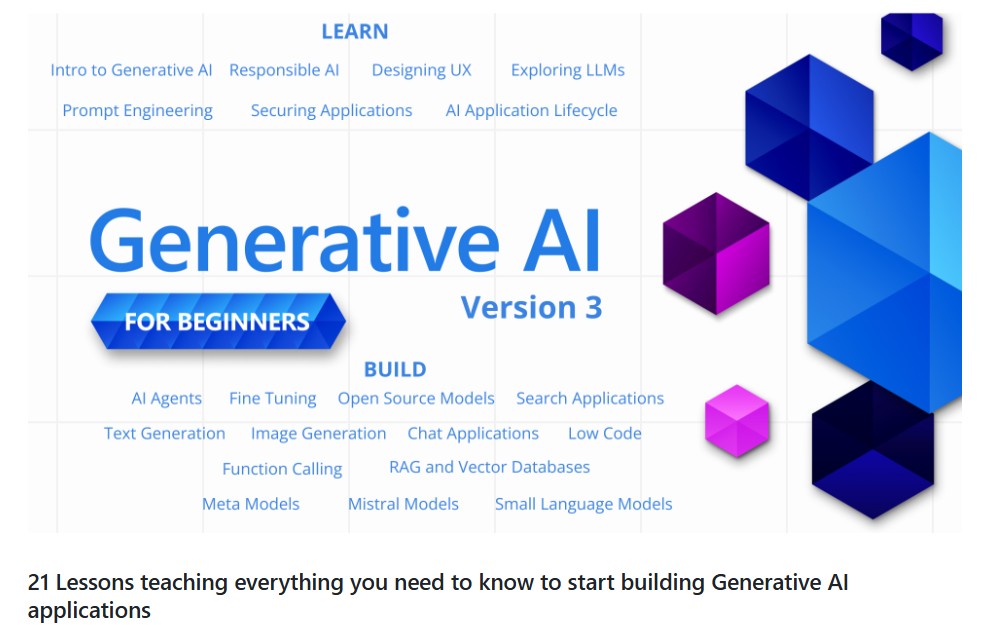Generative AI has rapidly shifted from an emerging technology to a foundation of modern digital innovation. From automated writing assistants and AI chatbots to image generators and intelligent search engines, generative AI is transforming industries and shaping the future of work. Whether you are a student, a budding developer or a technology enthusiast, learning generative AI skills today can open the door to countless opportunities tomorrow.

Microsoft’s Generative AI for Beginners course is one of the most comprehensive, beginner-friendly, and fully free resources available online. Designed by Microsoft Cloud Advocates, this course consists of 21 lessons that guide learners through the core concepts, ethics, tools and hands-on development techniques needed to build real-world AI applications. It covers everything from understanding large language models and prompt engineering to building chatbots, image generation tools, low-code solutions and Retrieval-Augmented Generation (RAG) systems.
This blog provides an in-depth overview of the course, highlights its major components and explains why it is an ideal starting point for anyone aiming to build skills in generative AI development.
What Makes This Course Unique?
For Absolute Beginners
No prior advanced AI knowledge is required. Basic familiarity with Python or TypeScript helps but even complete beginners can follow along thanks to the structured format, starter code and clear explanations.
Hands-On Learning
Each lesson includes video guidance, written explanations and code samples that work with:
- Azure OpenAI Service
- GitHub Model Catalog
- OpenAI API
This gives learners the flexibility to practice using multiple AI platforms.
Modern AI Concepts
The course stays relevant by including lessons on modern topics like:
- AI Agents
- Function calling
- RAG and vector databases
- Open-source models such as Mistral and Meta models
- Small Language Models (SLMs)
This ensures learners understand not just foundational AI but also cutting-edge developments.
Multi-Language Support
The course is translated into over 50 global languages, including Hindi, Urdu, Bengali, Tamil, Marathi, Punjabi, Arabic, French, German, Japanese, Korean and many others making it inclusive for learners worldwide.
Course Structure and What You Will Learn
Below is a breakdown of major themes covered across the 21 lessons.
1. Foundations of Generative AI
The course begins by explaining what generative AI is, how large language models work and how they power text, image and search applications. You gain a clear understanding of:
- Neural networks and transformers
- Differences between pre-training, fine-tuning and RAG
- Types of generative AI models
2. Responsible AI
Ethical AI development is a core section. You learn about responsible usage, bias mitigation, safety guardrails and why ethical practices are crucial when building AI systems.
3. Prompt Engineering
Prompt design is the backbone of AI interactions. The course teaches both foundational and advanced prompt engineering allowing you to:
- Improve output quality
- Structure task-oriented prompts
- Apply chain-of-thought prompting and other techniques
4. Building Real Applications
You build practical AI solutions including:
- Text generation apps
- AI chatbots
- Search and recommendation systems using embeddings
- Image generation tools
- Low-code AI applications (ideal for non-developers)
5. Advanced AI Development Practices
The course progresses into real-world development topics such as:
- Function calling for tool-integrated AI
- UX design for AI interfaces
- AI application security and threat mitigation
- AI model lifecycle and LLMOps
6. Working With Models
Finally, you gain exposure to multiple AI architectures and providers. Lessons focus on:
- OpenAI models
- Azure AI ecosystem
- Hugging Face open-source models
- Mistral models
- Meta Llama models
- Small Language Models for efficient deployment
This versatility ensures you are prepared to build with the best tools for any use case.
Why You Should Take This Course ?
Industry-Relevant Skills
Generative AI is one of the most in-demand fields in tech. Learning these skills prepares you for roles like:
- AI developer
- ML engineer
- Prompt engineer
- AI product designer
- Automation specialist
Free and High-Quality
Unlike many paid bootcamps, Microsoft offers this course at no cost yet with professional-grade content, GitHub examples, and community support.
Future-Ready Learning Path
You gain access not only to this AI course but also to other foundational Microsoft learning tracks enabling a full upskilling journey across AI, cybersecurity, web development and cloud computing.
Conclusion
Generative AI represents the next frontier of digital transformation, and acquiring AI skills today can give you a competitive edge in the global technology landscape. Microsoft’s Generative AI for Beginners course is one of the most powerful, structured, and accessible learning resources available. Its comprehensive lesson plan, practical project-based structure, and support for multiple tools and languages make it perfect for anyone eager to enter the world of generative AI development.
Whether you are a student preparing for the future, a professional reskilling for new job roles or a creator looking to build AI-powered tools, this free course equips you with essential knowledge and hands-on expertise to begin your AI journey with confidence.
Follow us for cutting-edge updates in AI & explore the world of LLMs, deep learning, NLP and AI agents with us.
Related Reads
- Open WebUI: The Most Powerful Self-Hosted AI Platform for Local and Private LLMs
- Dify: A Powerful #1 Production-Ready Platform for Building Advanced LLM Applications
- LMCache: Accelerating LLM Inference With Next-Generation KV Cache Technology
- Chandra OCR: The Future of Document Understanding and Layout-Aware Text Extraction
- Pixeltable: The Future of Declarative Data Infrastructure for Multimodal AI Workloads

2 thoughts on “Generative AI for Beginners: A Complete Guide to Microsoft’s Free Course”